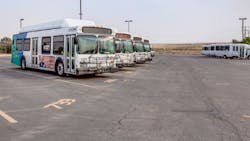Valley Regional Transit to implement redesigned bus network June 3
Valley Regional Transit (VRT) will implement its redesigned bus network on June 3, also known as Change Day for VRT. The agency, which serves the Boise, Idaho, area, notes that the redesigned network, which was approved by VRT’s Board of Directors in October 2023, is the culmination of more than a year of planning, collaboration and public input. To celebrate the new service, VRT bus and Access paratransit rides will be fare-free from June 3 to June 8, spanning the first week of service.
“We are thrilled to launch our new bus network on Change Day, which has been designed to provide better connections for our community and enhance the transit experience for riders,” said VRT CEO Elaine Clegg. “I am excited to see the positive impact this will have on the lives of our riders and the future of public transit in our region and I hope you join me on board.”
The new network features improved bus routes, enhanced bus stop signs, better access to major destinations and improved passenger amenities. The changes aim to streamline travel experiences, reduce wait times and increase accessibility for all riders and includes:
- Consolidation of less-used bus routes, reducing bus routes from 22 to 19 and allowing for a 12 percent increase in frequency and a seven percent increase in overall service.
- Focused frequency improvements along Boise's “best in class corridors” for routes 3 Vista, 7 Fairview and 9 State St.
- Connection to more frequent service across the system, with 34 percent more people near 15-minute bus service and 54 percent more people near 30-minute bus service.
- A new Route 20 Orchard, which provides a new north-south route from the Boise Airport to the Boise foothills at 36th & Hill Rd.
- A 160 percent larger service area for the redesigned VRT Lyft Pass; the pass provides $2 Lyft rides to and from select bus stops, which grows from 15 stops currently to 62 eligible stops.
- Improved intercounty and cross-town connections, with improved transfers between routes and better access to major destinations across the region.
- New, color-coded routes, route brochures and bus stop signs for better visibility and the addition of route details at each stop to improve passenger information.
Significant public input guided the redesign process and, with funding support from the city of Boise, VRT maintained service previously slated for removal, including service to southeast Boise with a redesigned Route 17, north Boise with restructured routes 10 Hill Rd. and 16 VA-15th St. and the Central Bench with a modified Route 4, serving Borah High School and sections of Latah.
VRT designed these changes to improve transit for most of the community. Improvement projects such as VRT’s ETA Spot app for live-tracking buses, the Umo Mobility app for trip planning and mobile fare payment and onboard passenger information screens have also been implemented to improve the passenger experience.
VRT notes riders may notice some bus stop signs that have already been replaced. All remaining bus stop signs will be replaced the weekend before Change Day. There will also be temporary stop signs placed on new locations along the expanded routes, which will be in place until summer when VRT completes the installation of permanent signage.
VRT is providing additional resources to ensure riders are prepared for the new network, including:
- Trip planning assistance and shareable content at VRT’s website, where rides can submit a trip plan request, download shareable graphics and print Change Day materials to help spread the word.
- An interactive map to explore the new bus network at VRT’s website.
- In-person support at VRT’s Customer Service desk, community events and pop-up engagements so riders can interact with VRT staff, get trip planning help and pick up VRT merchandise.
- Ambassadors riding throughout the bus system to share change information, new route brochures and help riders navigate the change.
